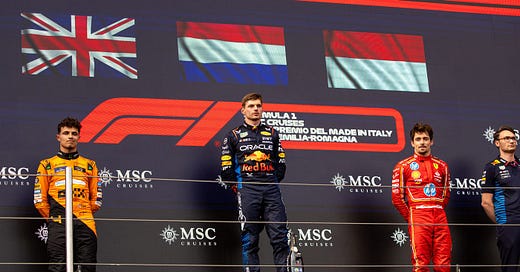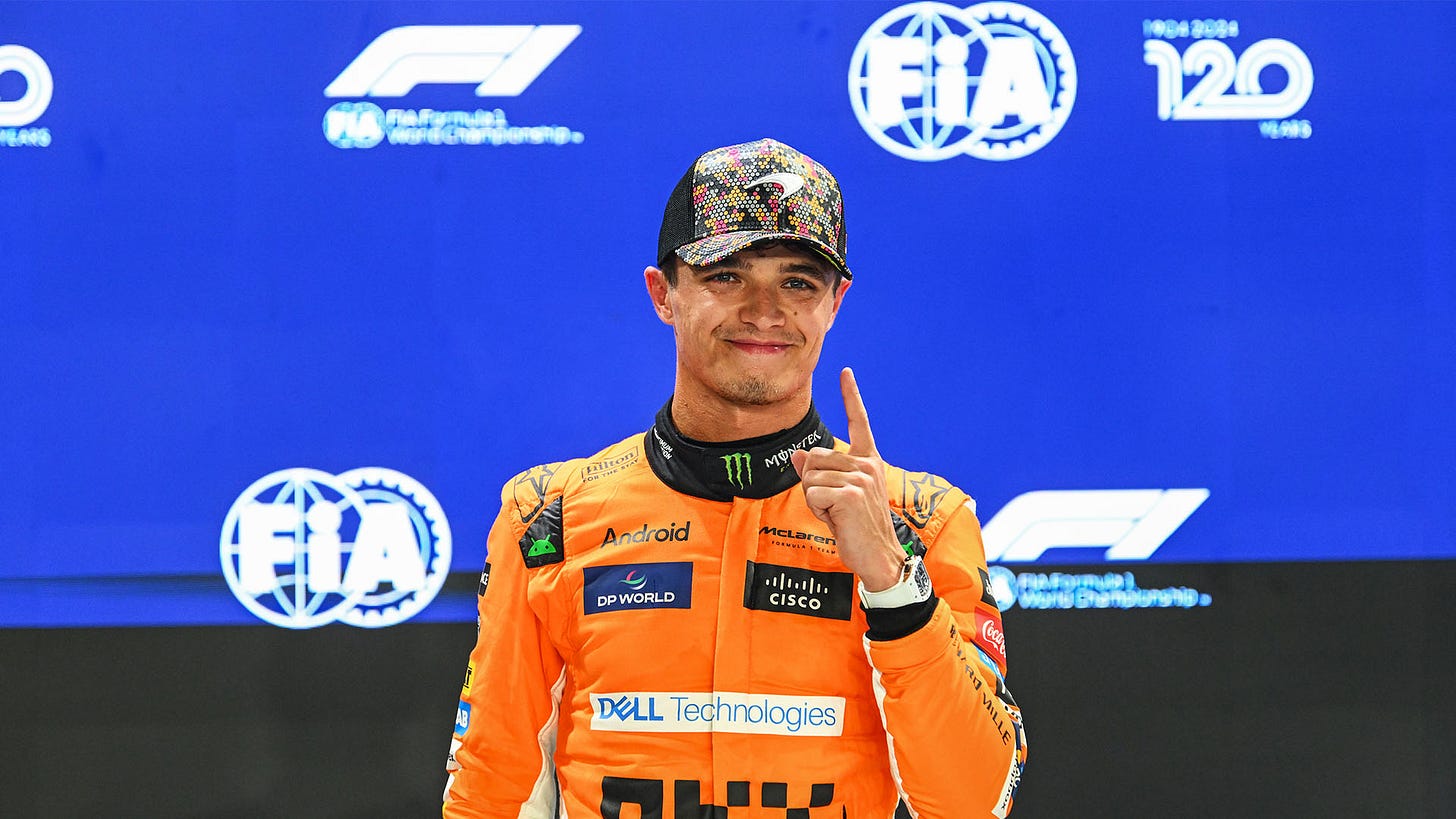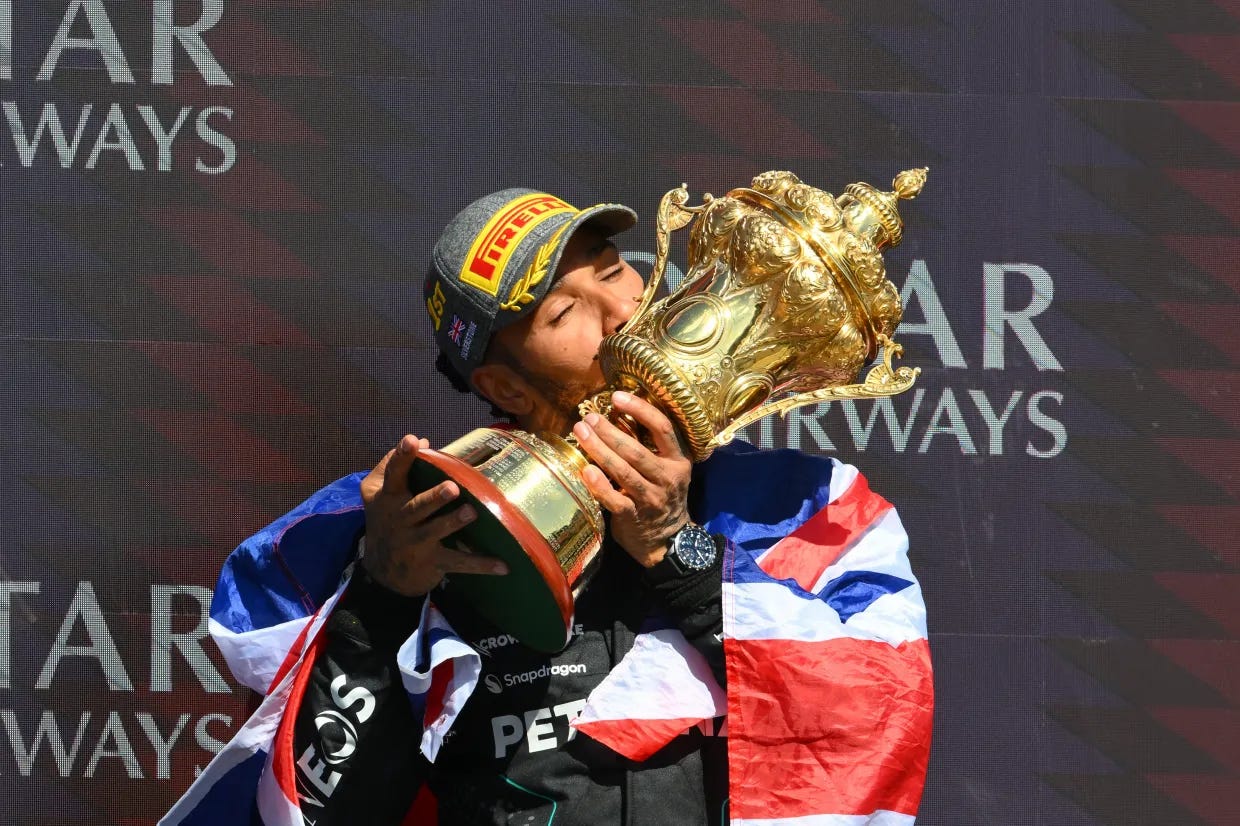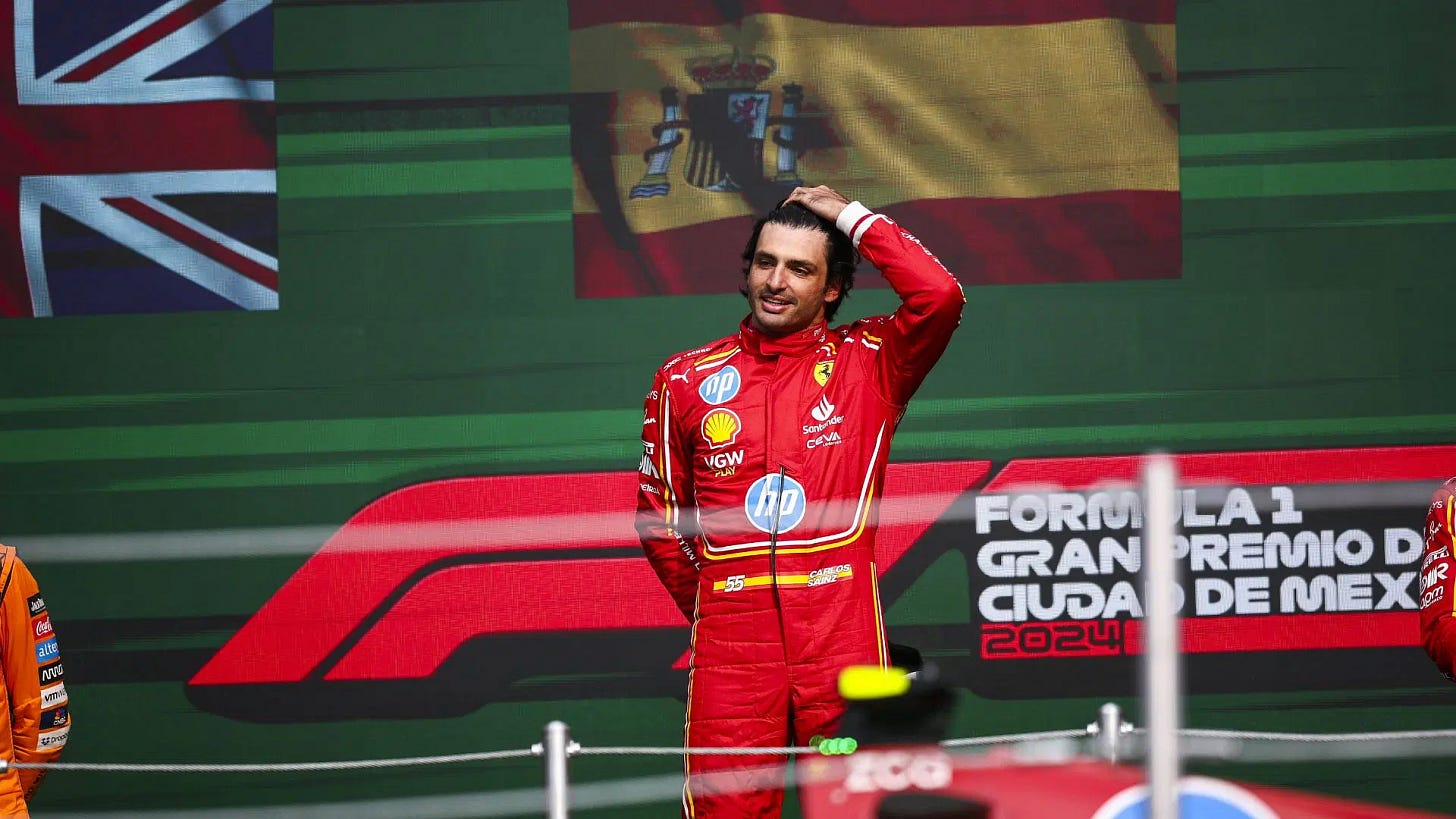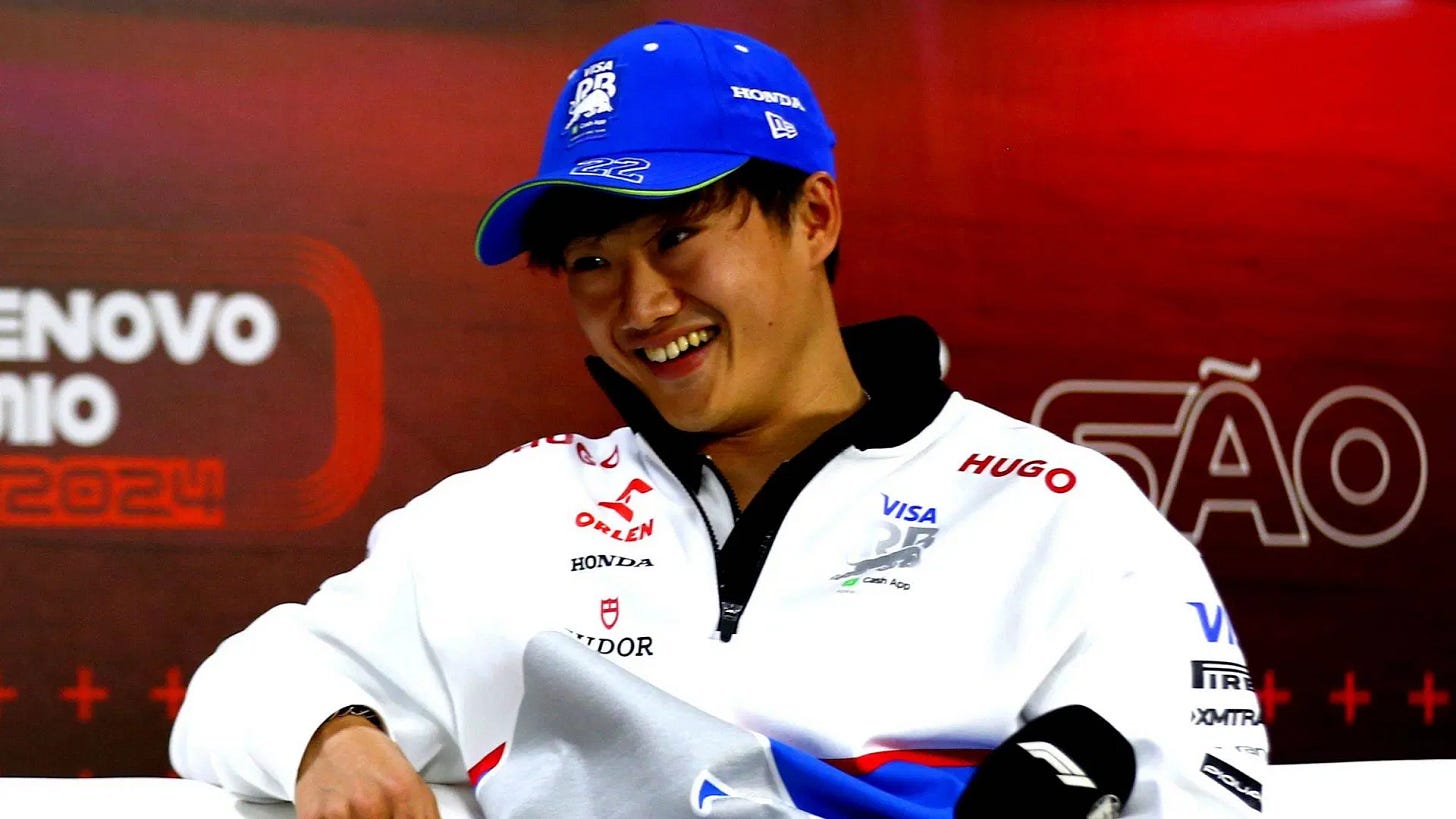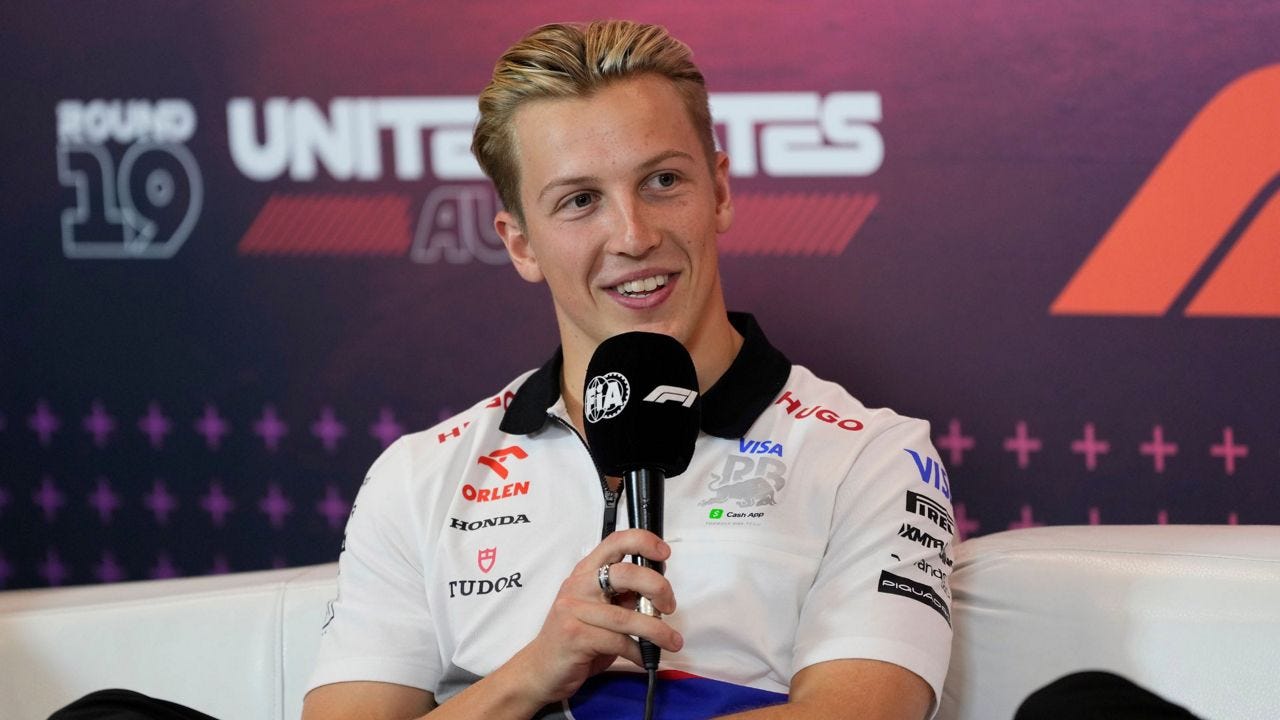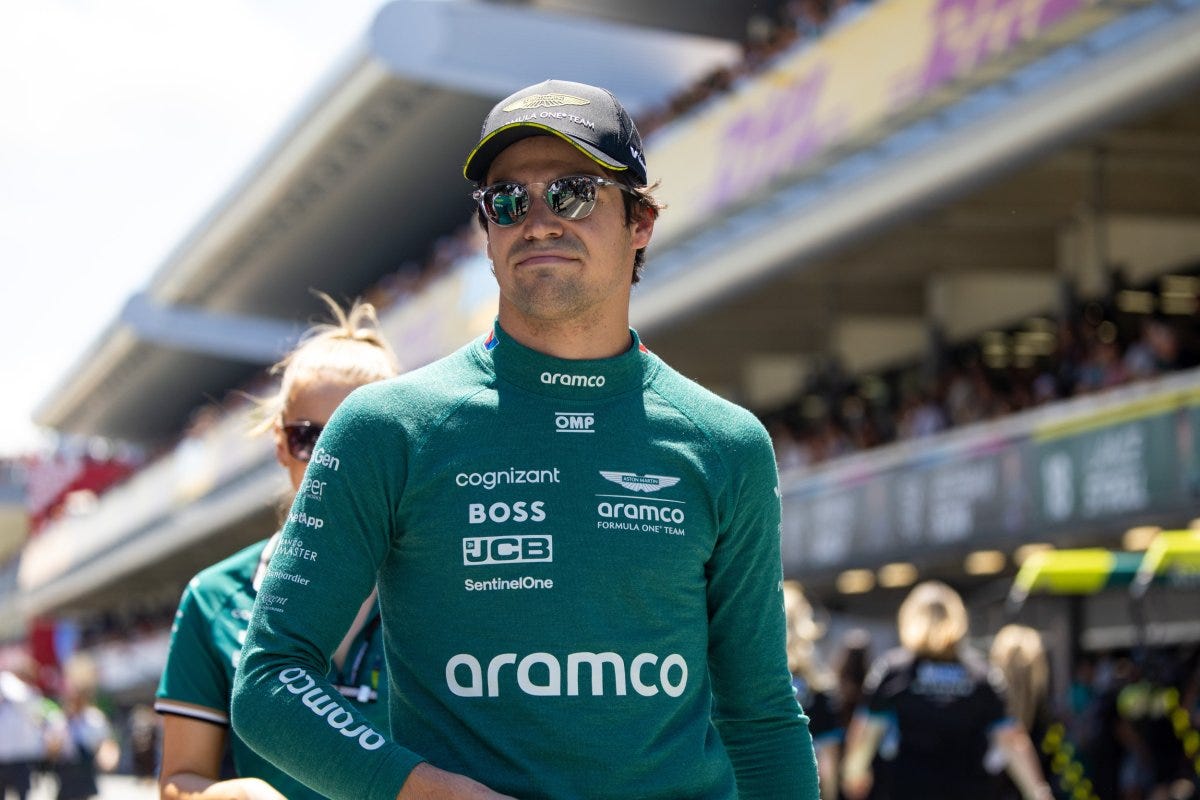RACES and Ruminations (PART I)
Introducing a ratings model to identify Formula One's MVPs in 2024
It might seem odd to open Omakase Formula’s 2025 with some final ruminations on 2024. But this isn’t just a recap post. Along with some final musings on the 2024 Formula One season, I’m incredibly excited and proud to introduce a model to help determine which drivers on the grid performed best over the course of the season! This post covers the model itself. Part II will cover some “awards” for the 2024 season.
So without further ado, let’s get into it:
Introducing RACES
What is it? Racer Achievement and Contribution Evaluation Score (RACES) is a model that determines the MVPs (and LVPs) of the Formula One season.
Why is it necessary? While it’s nice to hand out grades (be it letter or numerical) to each driver’s season as if they were test scores, doing so often involves placing weight on biases and expectations that can help or hinder a driver.
For example, Formula One’s own “Power Rankings,” which is determined by averaging scores from a five-person judging panel after each race, had Lando Norris on top at the end of the season ahead of Max Verstappen. From a results perspective, this wouldn’t make sense—Verstappen won the Drivers’ Championship. But from an expectations perspective, this could track: a three-time world champion winning a fourth title in a long-competitive car might not impress or exceed expectations in the same way a first-time challenger driving a newly competitive car might.
But what exactly are these “expectations” rooted in? The answer, in this case, seems to be personal opinion. And sure, Formula One says their judges are all “experts.” But you can’t tell me experts don’t have preferences, and any decision that might even slightly involve personal opinion will always fail to be completely “objective.” And anyone who insists they’re capable of “disregarding” their personal opinion is lying.
So why not just look at the World Drivers’ Championship standings? Because winning a Drivers’ Championship requires both a good driver and a good car. And the latter is what the drivers’ standings won’t properly tell you. Sure, you could probably guess from looking at the results which cars were the best and worst. But there are still clear factors that help or hurt drivers here. For example, Franco Colapinto finished 19th in the standings. However, is it fair to automatically proclaim him the 19th-best driver when he only raced nine grands prix, not to mention the situation under which he made his debut?
Why not use an Elo rating? An Elo rating is helpful for most sports, but it runs into an issue when it comes to Formula One: it fails to distinguish between the car and the driver. This wouldn’t have been a problem back in the early days of the sport, but engineering today is so advanced that a driver’s performance is highly influenced by the car they’re driving. It’s the reason why Aston Martin will pay Adrian Newey £30 million per year to design their car. For comparison, only two drivers are estimated to have earned more than that in 2024, even after accounting for bonuses.
Is RACES perfect? Of course not! You could exclude components I’ve included for the model, or include components I’ve excluded. You could even include the exact components I’ve incorporated in the model, but get different results by applying different weightings. These aspects of the model admittedly come down to personal opinion, and I won’t claim to be the number one authority when it comes to Formula One! However, I do believe RACES offers a more “objective” view on driver performance because it’s rooted in results and calculable statistics. Even the numbers for the Handicap—the only component in RACES that required some estimation—were partially derived from calculations of differences between previous rookie-veteran teammate pairs. At the very least, RACES ensures every driver’s results for a season are run through the same formula, meaning there’s no room to modify a driver’s score based on what we might think a driver “should have” achieved.
So how does RACES work? Put simply:
RACES = [ [(GRID SCORE (GS) + TEAM SCORE (TS)) x HANDICAP (HC) x STANDARDIZER (ST)] - CAR SCORE (CS) ] x 100
Here’s what each component means:
GRID SCORE (GS):
This reflects a driver’s performance relative to the rest of the grid. It’s determined by the points a driver scores during the season, how many wins, podium finishes, and points finishes they have, and qualifying performance. It also penalizes race retirements due to driver error (accidents/collisions). It can be hard to determine who is at fault in a collision (sometimes stewards will rule that no one was to blame), and the model doesn’t make that distinction when applying the penalty. While lumping every retirement due to accidents or collisions may unfairly include drivers who were not at fault, this penalty is weighted lightly when calculating the GS, meaning it will only significantly impact a driver’s score if they constantly gets into accidents—at which point the model reflects the fact their racecraft suffers from this issue.
TEAM SCORE (TS):
This specifically compares a driver’s performance with the only other person on the grid in the same machinery: their teammate. It’s determined by how much of a team’s total points a driver accounts for, as well as their race and qualifying head-to-head results versus their teammate. It also includes a performance gap modifier to control for situations where one driver might vastly outperform their teammate. The modifier is important: at a certain point, the line between a driver outperforming their teammate because they are the superior driver and a driver outperforming their teammate because their teammate is vastly inferior begins to blur. Having the performance gap modifier ensures we don’t see a wild outlier solely due to a driver having an inflated team score. Zhou Guanyu scored Sauber’s only points of 2024, which on paper is great for his TS! But he still only scored four points, which is nowhere near impressive enough to warrant him moving up the RACES ranks—even if he was driving the worst car on the grid.
Including this apples-to-apples comparison in RACES reflects real-world decision making too: teams rely on comparing their two drivers when making lineup decisions, as it’s the only comparison where they don’t have to account for differences between cars. But that’s not to say TS can’t offer additional perspective when comparing drivers on two different teams. You could say Lance Stroll had a better 2024 season than Alex Albon given the former outscored the latter 24-12—a 2:1 margin! But that doesn’t sound nearly as impressive when you realize Stroll scored only about 25% of Aston Martin’s points, while Albon accounted for about 70% of points scored by Williams.
HANDICAP (HC):
Adapting to the world of Formula One is difficult, and it would be unfair to compare a rookie to a seasoned veteran. Therefore, the model has a multiplier to address this discrepancy in experience.
For a rookie driver (must be the full-time driver for a seat and have raced at least 20% of the season), HC = 1.25
For a second-year driver, HC = 1.1
For every driver in their third year and beyond, HC = 1
STANDARDIZER (ST):
Drivers can enter and leave midseason or miss races due to illness/injury. It would be unfair to not account for that, since not competing in a race means you lose out on an opportunity to increase your standing, both in RACES and in the Drivers’ Championship.
The calculation for the standardizer is simple: ST = total races/races a driver competed in
CAR SCORE (CS):
This evaluates the capability of a driver’s car. It takes into account a team’s overall results for the season and the car’s reliability, while using average finishing position to reflect the car’s competitiveness relative to the entire grid. Admittedly, a team’s results do depend on the driver, so at the end of the day you can’t completely separate man from machine. But having the CS examine a car’s performance through the lens of both drivers and using metrics that don’t appear in the GS and TS makes it so the CS is reflective of a car’s capability without relying on driver performance metrics already accounted for in other parts of the model. You could try and use other metrics such as lap times, but those wouldn’t solve this issue either. After all, you can only gauge how fast a car is when someone is driving it!
Note that the model doesn’t include anything to control for whether a team is a factory team or customer team, which is something I’ve seen some other models try to do. It’s a valid point to consider and is discussed a lot, but I think a lot of those discussions are overstating the importance of this distinction. Case in point: this year’s Constructors’ Champions are a customer team (McLaren use Mercedes engines). Meanwhile, Alpine are a factory team, but they spent most of the season dueling in irrelevance with Williams (a customer team) before their late surge allowed them to fight with Haas and RB…which are also customer teams.
THE TIEBREAKER:
Formula One breaks ties when multiple drivers have the same number of points, so I thought it would be better to have some form of tiebreaker as well (the question of whether or not to have a tiebreaker also came up because there was a tie in 2024’s rankings). In order to determine the finishing order in RACES when scores are equal, the tiebreaker will compare the ratio of each driver’s GS to their CS. The driver with the greater GS/CS wins the tiebreaker and will be listed ahead in the ranking. This is because a higher GS/CS indicates a driver was able to perform better relative to their car’s capabilities. If a driver didn’t compete in every grand prix, their GS will be individually multiplied by the standardizer before calculating the ratio in order to make the comparison fair.
In the extreme case where the ratios are equal, the winner will be the driver with more race wins during the season. If it’s still tied after that, the tiebreaker moves to the driver with more runner-up finishes, and so on, until the tie is broken.
A quick note on my “favorite” sprint races:
I’ve decided to treat sprint races like fastest laps: bonus points and nothing more. Sprints aren’t full races, and there are only six of them in a season. Since only top 8 score points in a sprint, and winning a sprint only gets you as many points as finishing 6th in a normal grand prix, it would be unfair to weigh sprint results as if they were like a normal grand prix. If you score points during a sprint, that’s great and you’ll get the points. But it shouldn’t be the end of the world if you don’t.
A few important notes:
Ollie Bearman and Jack Doohan’s names and scores are italicized because they didn’t meet the thresholds required (both fell short of the 20% grands prix raced requirement, while Bearman also wasn’t the full-time driver in any of his races). In Doohan’s case, he only raced in the season finale and didn’t score points, so his score is left as Not Ranked (NR). Because Bearman did score points, his score is calculated here to accurately reflect where other drivers ranked compared to their Drivers’ Championship finish. Both will be considered rookies again in 2025.
Liam Lawson, however, will not be considered a rookie in 2025. He competed in 25% of grands prix this season after being named the full-time replacement for Daniel Ricciardo. He’d also raced five grands prix in place of Ricciardo back in 2023, so it would be unfair to view him as a rookie again next year when he’s already competed in half a season’s worth of races.
Some numbers to think about when looking at the chart:
127.0: Max Verstappen’s RACES in 2023. In a season where he became only the second driver (after Michael Schumacher in 2002) to score points in every race in a season, Verstappen won 19 of 22 grands prix and finished second at two more. While you could theoretically score higher, it’s very likely this is as realistically close to perfection as it’ll get.
77.7: Sebastian Vettel’s RACES in 2010. In a season that saw plenty of grid parity (there was a three-way battle for the Constructors’ Championship, and four drivers went into the last race with a mathematical shot at the title), Vettel came out on top to win his first of four titles while also becoming the youngest world champion. While 2024 wasn’t quite as exciting as 2010 (fun fact: Vettel never led the championship that year until he won it at the end), similar parallels in terms of parity (three teams fielding cars good enough to win the championship) mean that Vettel’s winning DVS is a solid benchmark for what you would need to at least score in order to have a “championship-worthy” season.
0.0: Yes, it is possible to score below zero in RACES—three drivers managed it this year! The realistic low bar a driver shouldn’t fall below is definitely higher than this, but it’s worth pointing out what falling below zero in this model means. A driver that scores below zero has not only failed to add any significant value to their team, but is most likely hindering the team with their performance (or lack thereof).
With that, here is every driver’s RACES for the 2024 Formula One season:
And here’s how RACES compares to the 2024’s World Drivers’ Championship (WDC) standings, as well as a few other rankings:
There are some differences, which is to be expected! Those differences (especially when it comes to changes vs. the Drivers’ Championship standings) can help illustrate who we could call an overperformer and who we could call an underperformer. Overall, I’m happy with how the model turned out. The results make sense from a numerical standpoint, but they also pass the eye test: if you followed the season (by watching races and/or via Omakase Formula’s recap posts) you’re probably not surprised by who the model points out as the best and worst.
Some comments on a few drivers:
Max Verstappen
I shouldn’t have to say anything. Unfortunately, I feel like I have to given a legitimate platform like Formula One’s own website is willing to roll with a wildly contrarian—not to mention wrong—take. Verstappen was the best driver of 2024.
RACES shows this. Despite not having the highest CS (meaning Red Bull didn’t have the best car), Verstappen had the highest GS. And he didn’t even get the biggest boost from his TS thanks to his teammate underperforming (more on that later).
If you still refuse to believe me, even 2024’s championship runner-up will tell you Verstappen was the best driver. Speaking of the runner-up…
Lando Norris
I’ll admit that hot takes on Verstappen not being the best driver of 2024 are few and far between (even if I personally find it wild those takes exist in the first place). On the other hand, it seems like there’s quite a bit of chatter about how Norris wasn’t the second-best driver of 2024. The problem with this take isn’t that he finished second in the championship.
The problem is that it’s just wrong.
Norris was the only driver besides Verstappen to clear Vettel’s 2010 RACES benchmark this season, so this alone should settle any discussion. However, that isn’t going to stop the naysayers, so I’ll delve into the matter a bit deeper by entertaining the argument for Charles Leclerc, the only other driver who comes anywhere close to challenging Verstappen (and Norris) on paper.
The main argument for Leclerc being better than Norris in 2024 is that he got close to Norris in a worse car. Even though Norris had more wins and more second-place finishes than Leclerc, the theory is the difference is solely the result of the McLaren being a superior car to the Ferrari. The most straightforward way to verify if Leclerc indeed outperformed Norris is to perform the tiebreaker calculation I mentioned above and examine their respective GS/CS ratios. Even if their ratios are equal, you could argue Norris only pips Leclerc in the rankings because of a higher TS. But doing the calculation shows Norris has the superior GS/CS (1.427 vs. 1.375). So while Norris did have the better car, he was also able to extract more performance from the McLaren than Leclerc was able to from the Ferrari.
So why do people seemingly think Norris wasn’t the second-best driver? The answer lies in expectations, specifically those set by the media. If you’ve read Omakase Formula’s recap posts, you’ll know I’ve always been realistic about Norris’s title hopes. It was possible, but a relative long shot. However, this sentiment was not shared by anyone doing post-race commentary, with analysts treating this situation like it was 2021 and playing up every result where Norris finished ahead of Verstappen as a big step towards the title.
The most obvious example of this was Singapore. Norris’s win was very impressive (more on that in Part II), but all the commentators describing this as a “huge” dent in Verstappen’s lead missed the bigger picture: Verstappen finishing second meant Norris didn’t outscore Verstappen by the 8-point average he needed despite winning. While this was brought up in Omakase Formula’s Singapore recap, post-race commentary (such as this episode of the Sky Sports F1 Podcast) instead painted a picture where Norris could go on a tear and win all the remaining races—a wild idea given how competitive this season was. And I would argue that wasn’t even the most baffling championship take that episode had (why are we asking whether sprint races will matter when the championship gap is 52 points? Norris winning the remaining sprints would have given him 24 points, but Verstappen finishing second in those would have meant Norris made net gain of three).
I also would’ve loved to see the championship go down to the wire, so I admire the optimism shown by the pundits. But saying the improbable is very possible automatically lends itself to backlash when things don’t work out. And when that happens, Norris ends up bearing the brunt of the criticism because he suddenly looks like a flopping challenger. Fixable issues suddenly become the reason he “can’t win a championship.” For example, there was a lot of criticism made about his horrible record of winning from pole position and how this wouldn’t be the case for any other driver. I’ll admit, 3 of 8 this season is not great and needs work (Verstappen was 5 of 8). But it shouldn’t disqualify him from being considered a driver who could win a championship. Mikka Hakkinen won his second title in 1999 despite being a dismal 3 of 11! And it’s worth pointing out 3 of 8 is still better than the other non-Verstappen drivers with multiple starts from pole this season (Leclerc was 1 of 3 and George Russell was 1 of 4). So if you truly believe Norris is incapable of challenging Verstappen because of a statistic like this, I’m at a loss as to why you would then think any of the other alternatives would have definitely done better in 2024.
At the end of the day, Norris’s 2024 title challenge draws more parallels to Vettel’s 2009 challenge than any 2021-esque shootout: a driver-team pairing learning on the fly how to compete up front and win. Considering McLaren’s goals at the start of 2024 were a top 3 finish in the Constructors’ Championship and a maiden grand prix victory for Norris, a somewhat close title race and helping McLaren win the team title is a more than respectable season. Norris definitely was not the best driver of 2024. But he definitely was the second-best, no matter what the detractors claim.
George Russell
Let’s get the disqualification in Belgium out of the way: had Russell kept the win, his RACES would’ve still been below Vettel’s 2010 baseline. He would also still be (albeit only barely) behind Leclerc’s RACES, even when you account for the impact Russell winning would have had on Leclerc (who was elevated to the podium after the disqualification). So overall, Russell’s performance in 2024 still falls below the trio of Verstappen/Norris/Leclerc.
It is interesting, however, to see Russell being ranked lower in most other rankings than the likes of Piastri and Sainz. I do understand the logic—the latter two had more podiums and a higher finish in the Drivers’ Championship. But they also had much better cars. Yet despite the disadvantage, Russell was 1.5 kg away from winning more races than them. Even if the actual result in Belgium does somewhat course-correct (Russell had absolutely no business winning Austria), having the same number of wins as drivers who were in two of the strongest cars of the year is impressive and deserves more credit. The drivers seem to agree, as Russell’s ranking in the drivers’ poll aligns with his placement by RACES.
Lewis Hamilton
Given the stories of their respective seasons are inextricably linked, it’s incredibly fitting that Hamilton and Sainz ended the season tied. Per the tiebreaker, Hamilton ranks ahead by virtue of a superior GS/CS (1.184 vs. 1.158). This reflects why Ferrari jumped at the chance to sign him for 2025. It’s not that Sainz was poor—it’s just that few drivers have Hamilton’s ability to squeeze as much performance as possible out of the car they’re driving.
Admittedly, Russell’s disqualification at Spa looms large here, since it handed Hamilton the win. A revised calculation where Russell wins results in Sainz finishing ahead of Hamilton. But while the change in result is worth mentioning, I don’t think it’s enough to overrule the model and say Sainz was definitely the better driver this season. Unpredictability is a part of racing (or any sport). If you wanted to justify why one driver was better than the other by litigating one hypothetical, you would have to litigate all of the other hypotheticals as well in order to get the full picture. Yes, Hamilton benefitted from Russell’s disqualification. But Sainz was only on the podium in Austria because Verstappen and Norris crashed into each other at the end of the race. If you kept going around that carousel, the results would become so warped you’d end up with a completely different season.
I also think there’s an intangible not covered by RACES that further illustrates why Hamilton is the stronger driver and why Ferrari were right signing him. There was a lot of talk throughout the season of the difference in mentality between Sainz and Hamilton. For Sainz, the prospect of suddenly being without a seat for 2025 meant we saw a highly motivated version of him throughout 2024. Every race wasn’t just an opportunity to get wins and podiums while he was in a car capable of doing so, but also an audition for other teams to demonstrate he can deliver results when given solid machinery. On the flip side, Hamilton more or less seemed to go through the motions in 2024. It became clear (especially by the season’s end) that his partnership with Mercedes had grown stale and he needed a new challenge to motivate him. That, along with everything Hamilton has already accomplished in his illustrious career and the season’s top line results, help explain why other rankings have Sainz ahead.
You might be thinking what I just said sounds like an argument for Sainz. However, I think the fact that Hamilton still matched Sainz in RACES despite the difference in how each of them approached the season mentally speaks to just how good Hamilton is. If this version of Hamilton, who didn’t operate near full capacity, is still just as good as the version of Sainz that did, it stands to reason that a motivated Hamilton will outperform Sainz. And the change of scenery for 2025 offers Hamilton exactly what he needs to become motivated again.
Carlos Sainz
I want to reiterate that Sainz wasn’t replaced at Ferrari because he was objectively poor in 2024 (he wasn’t) or severely underperforming (he only ranked 7th in RACES because he lost the 6th place tiebreaker to Hamilton, meaning Russell was technically the only driver who had a higher RACES than Sainz while finishing lower in the WDC). Ferrari had the opportunity to sign a legendary driver who is still performing well in Hamilton, and Sainz drew the short straw simply because he was unable to outperform Leclerc. It’s great that he’ll still be on the grid in 2025, though it’s somewhat a shame it’ll be with Williams—a team that, if their car is as bad as it was in 2024, I’m not sure even a driver possessing the greatest strengths of every Formula One legend could save.
Franco Colapinto
Did Logan Sargeant set the bar so low that it was basically underground? Yes.
Did Colapinto outperform everyone’s expectations? Also yes.
The multipliers do a bit of lifting here, and I don’t think Colapinto would have ranked as high as he did if he raced a full season. I also think the fact he only raced nine grands prix (not to mention the uncompetitive car he was in) explains why he doesn’t appear in any top 10 rankings. But that shouldn’t overshadow how much he impressed on short notice, and it’s likely Williams would have given him the seat for 2025 had they not already gotten Sainz. As for why other teams might not have poached him from Williams, the likely answer is they wanted to promote within their own ranks, which makes sense. Joining a team’s driver development program would be a tough sell for any young driver if they saw the team opting to bring in a rookie outsider instead.
Yuki Tsunoda
What more does Yuki Tsunoda need to do in order to earn a shot at Red Bull?
Given RB’s status as Red Bull’s sister team, you could argue the entire point of RB’s existence is to give aspiring drivers a chance to show they deserve a shot at a seat on Red Bull. In that regard, Tsunoda has done just that the last two seasons. He first outperformed Nyck De Vries, who many originally thought would do better than him. But when De Vries was sacked, the team pivoted towards Ricciardo, bringing the veteran back with the intention of having him move to Red Bull if Perez’s position became untenable. Instead, Tsunoda outperformed Ricciardo, who the team eventually concluded—correctly, according to RACES—wasn’t even performing well enough for RB. But even though RACES shows Liam Lawson was an upgrade on Ricciardo, it also shows he wasn’t particularly close to matching Tsunoda. Yet Red Bull decided to go with Lawson instead.
Red Bull’s rationale for choosing Lawson has to do with their belief he has a higher ceiling. We’ll examine that more in the Lawson section of this post, but the choice to go with “potential” over the established doesn’t bode well for Tsunoda. Even if Lawson doesn’t perform, what’s stopping Red Bull from using the exact same reasoning to pick Isack Hadjar over Tsunoda next?
As he heads into his fifth season in Formula One, it feels like this was Tsunoda’s best opportunity to get a shot at a Red Bull seat. That he didn’t get it means he should probably start looking for a new opportunity elsewhere. The options, however, are bleak. There could always be a midseason opening, but betting on circumstance isn’t ideal. Midseason openings are also almost always on less-competitive teams, and at this stage of his career Tsunoda should be looking to move forwards rather than sideways or backwards. The only possible team that could serve as an upgrade is Aston Martin (assuming Adrian Newey works his magic once more). With Honda set to be the team’s works engine supplier from 2026 and Fernando Alonso hinting he’ll retire once his current contract expires at the end of 2026, there’s likely going to be a behind-the-scenes push to get a Japanese driver on the team, especially when there’s already a qualified one on the grid in Tsunoda. But the team also has Felipe Drugovich waiting in the wings, and it wouldn’t be surprising if they chose to promote in-house instead. If Aston Martin were smart, they’d replace Lance Stroll with Tsunoda. But for reasons we’ll also discuss later, that looks extremely unlikely for all the wrong reasons.
Nico Hulkenberg
Comparing Hulkenberg’s RACES to his standing in various rankings illustrates the power of expectations. RACES places him 12th for the season, in line with his 11th place finish in the Drivers’ Championship. However, that’s four or five places below where he landed in any ranking.
The difference most likely boils down to him driving for Formula One’s most historically hapless team. Given Haas’s sterling reputation for mediocrity—if not inferiority—Hulkenberg’s frequent points finishes may have seemed at first like it was solely due to his driving. Kevin Magnussen’s performances only seemed to add to fuel to that argument. But consistently scoring points throughout a whole season would also suggest Haas may have actually managed to build a competent car. After all, RACES suggests Haas had a slightly better car than Alpine, which tracks: they had more consistent pace throughout the season and much better reliability. It would be a mistake, then, not to acknowledge the possibility Hulkenberg’s performance ended up being partially down to the car. But the discrepancy between where he finished in the WDC and RACES and where he ranked in more subjective polling seems to suggest there was an inability to properly adjust for expectations.
Liam Lawson
Even with the help of multipliers, RACES doesn’t think Lawson’s 2024 was particularly impressive. The race results reflect that assessment: not only has Lawson not performed as well as Tsunoda, he also still hasn’t finished a race above 9th place in his entire Formula One career. While a driver in an RB wouldn’t be expected to finish towards the front of the grid, Lawson’s results pale in comparison to Red Bull’s previous in-house promotions:
Lawson’s results for the Red Bull sister team are a record low for a Red Bull in-house promotion, which also makes his historically quick promotion even more surprising. Sure, Red Bull can say they’re promoting him due to “potential,” but that’s the same argument they made for other drivers in the table above. Going off precedent, his results most resemble Kvyat’s, which isn’t exactly a good omen. He could always surprise, but for now it’s hard to call Red Bull’s decision to roll with him anything other than a risky bet.
Lance Stroll
Aston Martin Team Principal Mike Krack claims there isn’t a significant difference between Alonso and Stroll. That sentiment is decidedly not shared by anyone who follows Formula One. RACES agrees with the general sentiment here: Stroll is the only driver with a score lower than 25 that still has a drive for 2025. Cue the obligatory reminder that the Aston Martin team is owned by Stroll’s father.
It’s not that Stroll is completely untalented: he became the second-youngest driver in Formula One history to score a podium when he finished third at Baku in 2017. However, there hasn’t been any clear sign of improvement since then. He’s only had two more podium finishes, both of which came back in 2020. In the last 90 grands prix, he’s only finished in the top 5 three times. You could blame his lack of results on Aston Martin having an uncompetitive car for most of that time, but his teammates across that same span still scored nine podiums. With how cutthroat Formula One is, such levels of underperformance would normally mean a driver would be out of a job. Stroll still having a job means that, barring any improvement, he won’t be beating the allegations he gets special treatment driving for daddy’s team.
Sergio Perez
Is Perez an overall worse driver than Logan Sargeant? No, even though it’s endlessly amusing that Sargeant never out-qualified Albon in a full grand prix during his Formula One career (he only started one regular race ahead of his teammate—and that was because Albon had been penalized), but managed to out-qualify Perez six times. However, RACES ranking Perez below Sargeant correctly highlights an important distinction between their respective underperformances. Sargeant definitely underperformed compared to Albon, but Williams’s car was largely uncompetitive to the point where it capped the possibility of him getting any results. Meanwhile, Perez definitely underperformed compared to Verstappen, yet Red Bull’s car was one of the strongest on the grid. Remember what I said in my final triple header recap: Perez’s 8th place finish in the Drivers’ Championship was the worst finish by a driver in a championship-winning car since 1994.
Unlike Sargeant, Perez probably could have—not to mention should have—done better. That he didn’t means his underperformance is contextually worse, despite him having the better season on paper.
Be sure to check out Part II, which covers Omakase Formula’s 2024 Formula One season awards!

